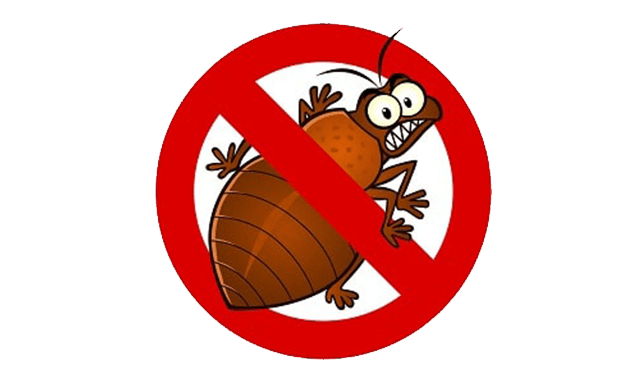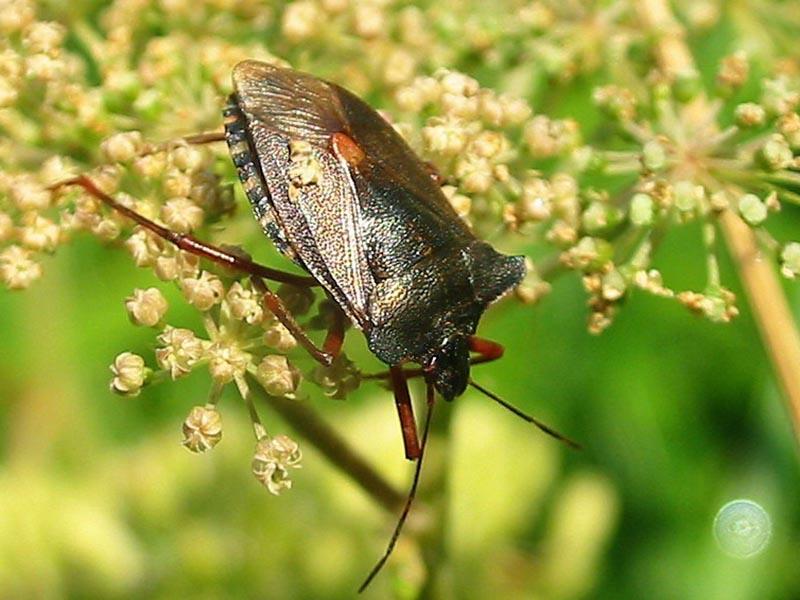
In the summer I treated the area, but not all insects responded to my action. I still found some here and there. I want to understand what I'm doing wrong: I remove them, but they appear again, I destroy them with insecticides, but this method is ineffective as well. The insects are very tenacious and harmful. I beg your help, advise me how to fight them. And preferably so that the result can be obtained immediately, since the site is now a very neglected me. Thank you.
The author of the portal answers the question:
In my material below, you will learn about all varieties of garden street bugs, and how to deal with them.
Garden bugs - what they look like, what they do and how they eat
Insects belong to the category of semiparasites. Most of them have many features in common, but there are some that differ not only in appearance but also in their way of life. Common features of garden bugs:
- oval body;
- flattened shape of the torso;
- 3 pairs of polychronytic limbs;
- 1 pair of tendrils;
- unlike domestic bugs, garden bugs have wings and can move through the air;
- The oral apparatus is of the stabbing-sucking type, and a short proboscis can be seen on closer inspection.
The garden bug feeds on the sap of plantings (wild, cultural).
Among these individuals are those that consume not only plant food, but also attack insects. To get a portion of the sap, it is enough to insert the proboscis into the tissue structure. As a result, the plant loses its attractiveness and soon dies.
Crop damage also has a negative effect on crop yields. To kill the insect, the bug first injects a special enzyme that changes the structure of the tissues. Then all that remains is to suck out the nutrients contained in the liquid substance.
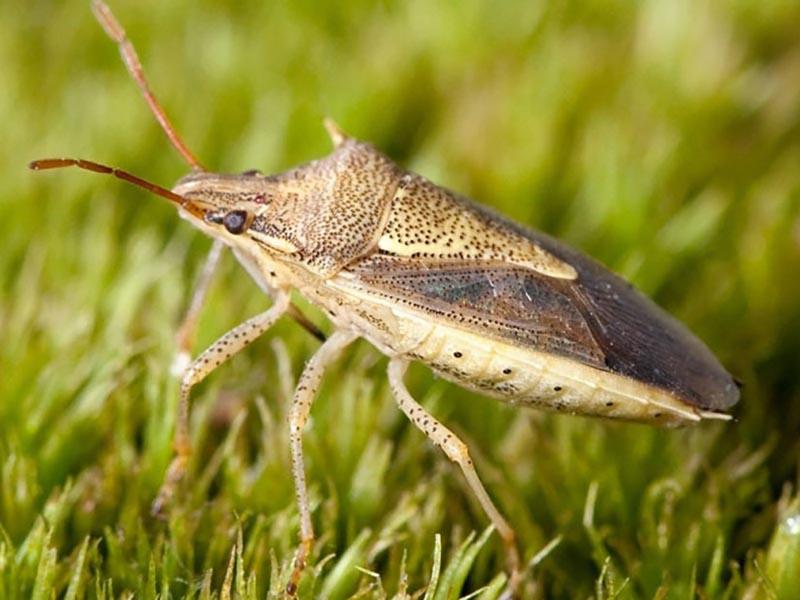
Close-up photos - variety of garden bugs, variety of colors
There are a large number of insects in the garden and vegetable garden. The most obvious difference between them is color. The chitinous coverings of garden pests are often bright. They have a way of warning others of danger.
So, if bedbugs feel threatened, they exude a specific, intense odor.
There are also inconspicuous species of these pests. Their coloring is yellowish or brown.
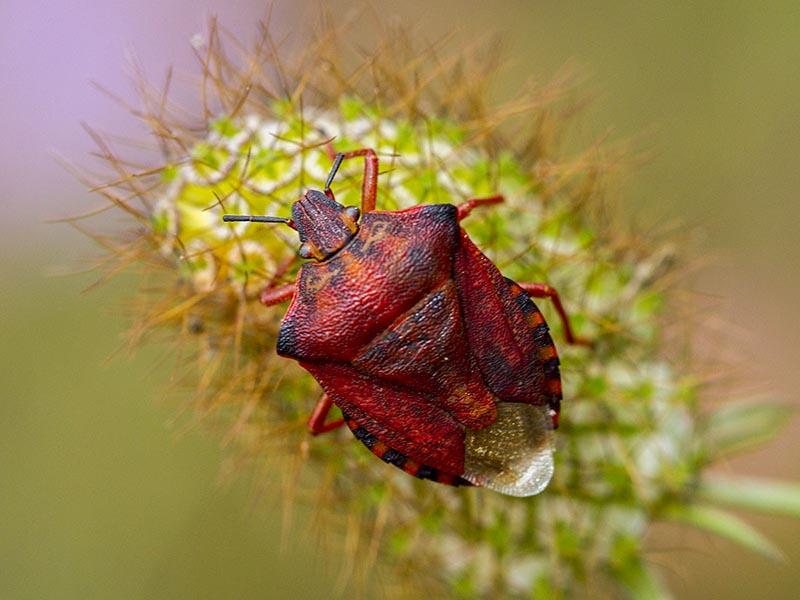
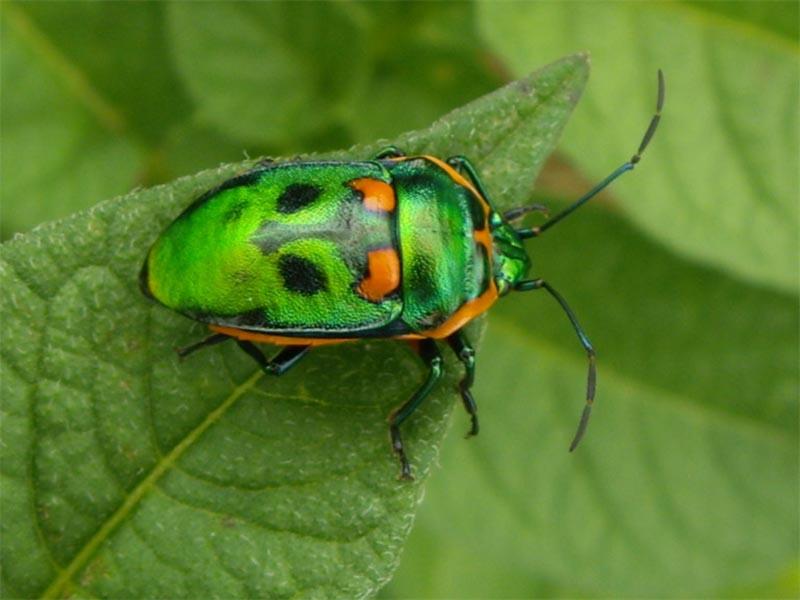
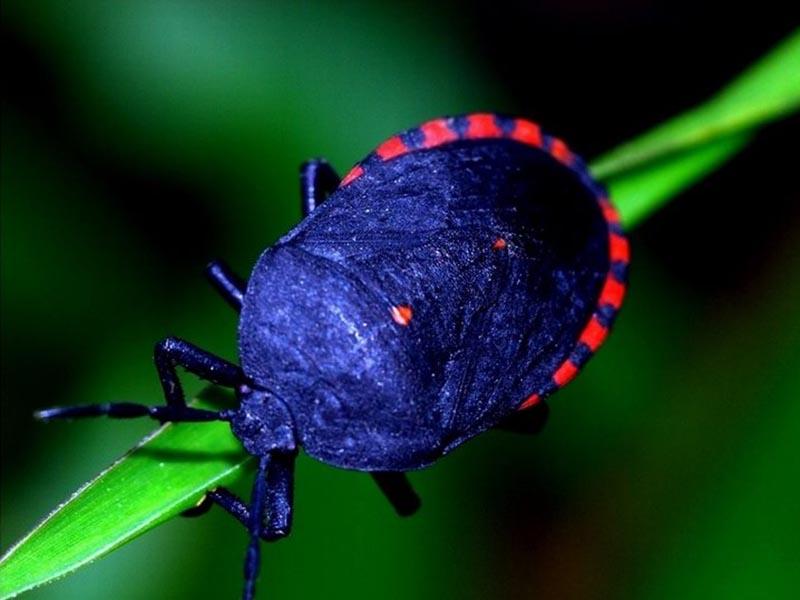
Shchetnik green woodland
Such pest can be overlooked on plants. It has green outer covers. Its body size is considerable, up to 15 mm. The insect is able to fly, but in a quiet state, the bug cannot see its wings, because the front wings are rigid, they cover the back wings - transparent.
These pests prefer to live on shrubs and fruit trees, feeding on the sap of plantings.
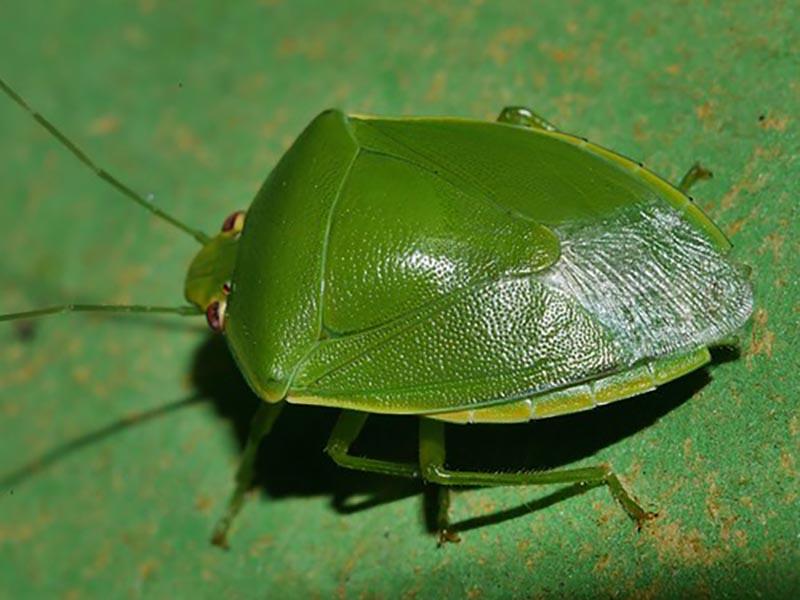
Eurydema nordicum
Garden bugs of this species are members of the Shieldworm family, like the previously discussed species. It is a small pest that is barely reaches 8 mm. But the color will not let him be confused with other specimens - yellow-black pattern on the pronotum.
The body is oval, flattened. The bug lives on cruciferous plants.

Berry Shield
The name speaks for itself. The insect represents the family Shieldworts. It is distinguished by its bright color - brown with a glossy sheen, with black and white punctuations along the edges. The pest has a trapezoidal body, resembling a shield. The body length is 10-12 mm.
Interestingly, the larvae of the first instars are black.
Despite their name, these bugs are polyphagous - they feed on plants of all kinds, including fruit plants, which the insects like best.

Cucumber bug
Externally, it differs from its brethren. It is a dark-colored (gray-black) insect, its body is narrow and elongated, and its rear part is rounded, not pointed, as in shields. The pest lives mainly on cucumbers, and the leaves gradually die off when the bush is infested.
The bug can jump high, for which jumping limbs are provided.
It is distinguished by its short length - up to 3 mm.
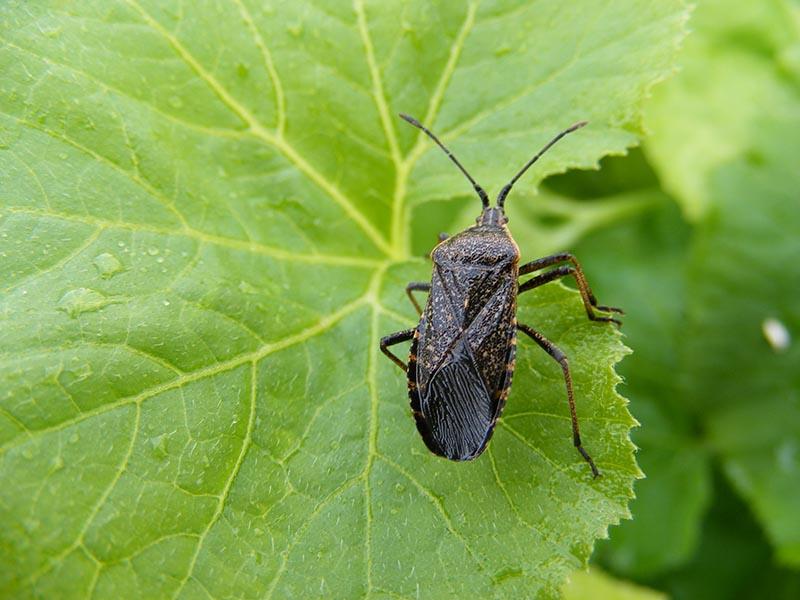
Pear Lacemaker
Despite the name, the insects destroy not only the pear crop, but also apples.
They can also feed on other Rosaceae plants
Depending on the region, 1 or 2 generations appear. These bugs are small - up to 3.3 mm in length, the cuticle is transparent, which makes the insect invisible, but on closer examination it turns out that the pest looks surprisingly attractive - due to the transparent cells on the outer covers, wings, it seems that the insect is covered with lace.
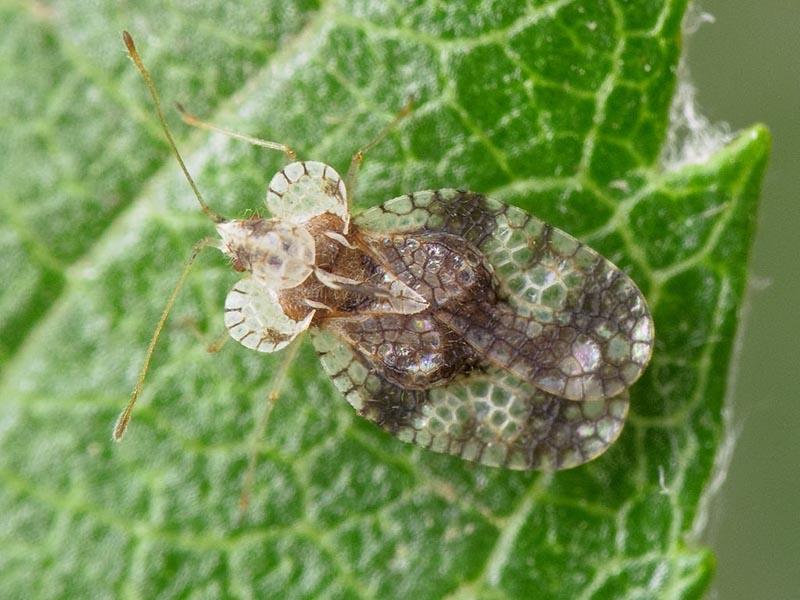
Shieldsnipe the pest turtle
This one has pest The chitinous sheath is more curved, which provides a resemblance to a tortoise. The coloration is brown; otherwise, the insect has the same external features as the other shield-bugs. The bug destroys crops and spoils crops as a result.
Flour from such grains does not comply with GOST.
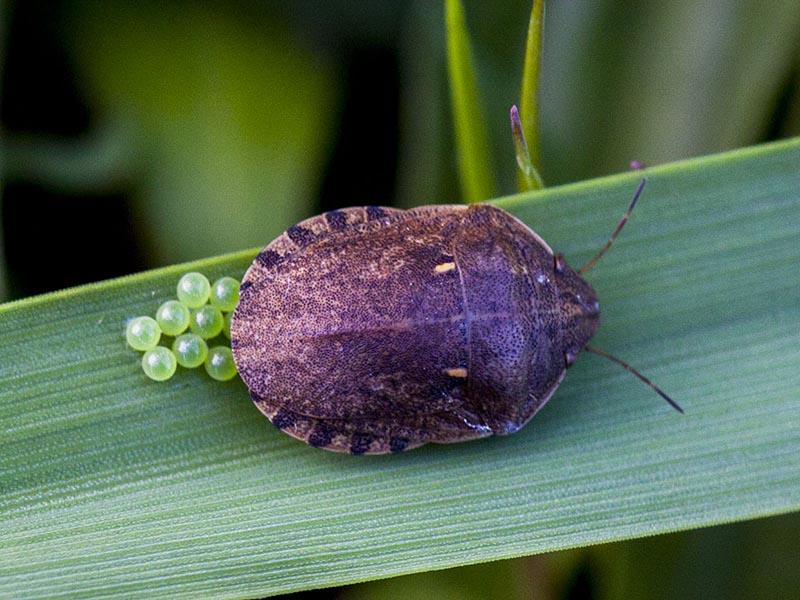
Mole bug
There are up to 10,000 species of these pests. They prefer to destroy wild and ornamental plants: azalea, sage, fuchsia, chamomile, etc. This bug differs from other species by its unusual appearance: it has compound eyes, spotted coloration and short front wings and longer, transparent hind wings.
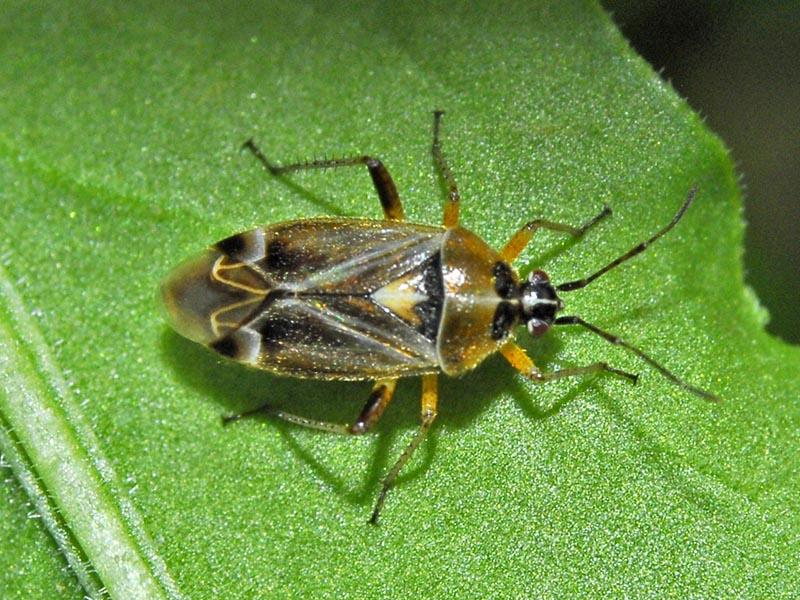
Ringed Predator
It is distinguished by its unusual appearance: the hind part of the body is rounded, the coloration is black, and there are orange punctures along the edges. This bug differs from shield-breeders and other specimens by the presence of a constriction in the middle of the pronotum. Among the species of these insects there are simply predators (they feed on other pests).
But there are also parasites that consume the blood of warm-blooded people, their bite is quite painful.
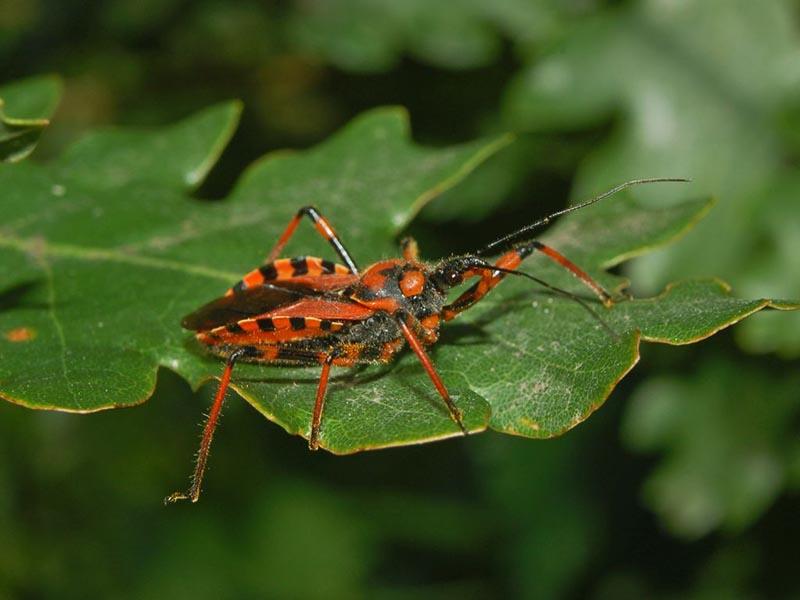
Currant bud mite
This pest lives literally inside the buds, which prevents the development of the bush. In this case it is not possible to get a harvest. The bug affects black currants, but can also be found on red and white currants. It can even destroy gooseberries. The body length is no more than 0.2 mm, which means it is difficult to detect the pest on external inspection.
It is advisable to pay attention to the shape and size of the kidneys to notice changes.
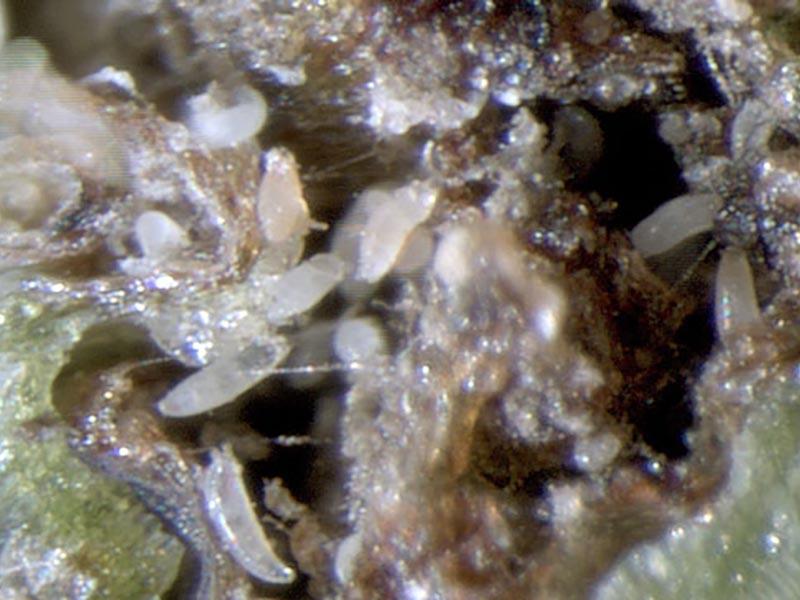
How plants are harmed. What causes them to die
When plant-eating pests bite, they inject their saliva into the tissues of the plantation. In doing so, they get sap with the properties they need, nutrients. But this method of feeding harms the plants: the cells begin to die off, first the external signs appear (spots of brown, yellow, white or black color). Their size increases as the poisonous substances spread through the tissues.
If there are many lesion sites on a leaf, it will soon fall off. This has a negative effect on the development of the plantation. First, their growth is inhibited, then the above-ground part of the plants is deformed. Internal changes in tissue structure have a negative effect on yield. In case of multiple punctures, plants die at the initial stage of development - in the seedling phase.

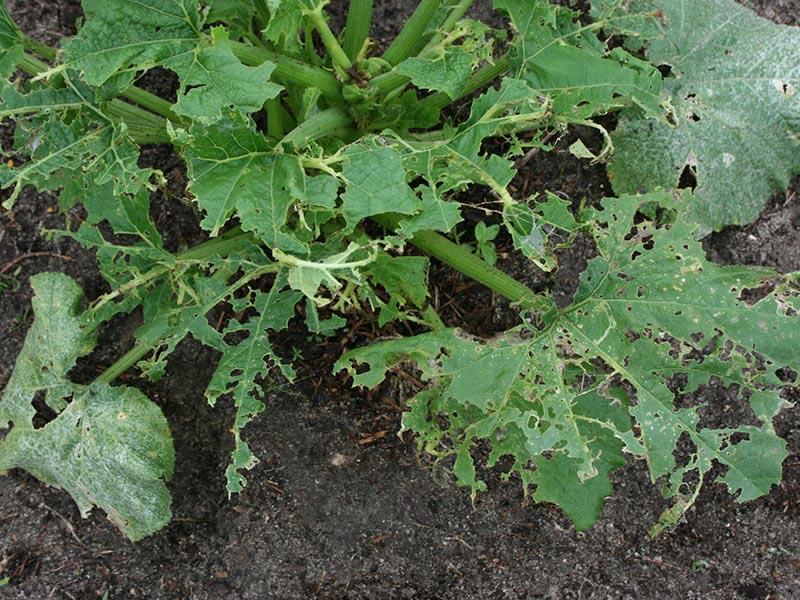
Are there any useful members of the species
Such Insects indirectly benefit plants. In fact, they are not interested in plantings, but they help to destroy pests that feed on the sap of crops (vegetable, fruit, cereals, etc.).
Perillus bicentenarius
It is the natural enemy of the Colorado potato beetle. It is distinguished by its black and red coloration. But it is not a soldier bug, it has a different pattern, and the pronotum resembles a shield: it is wide, the back part is narrower, and there is a roll closer to the head.
The bug attacks adult plant-eating pests as well as their offspring, including their eggs.
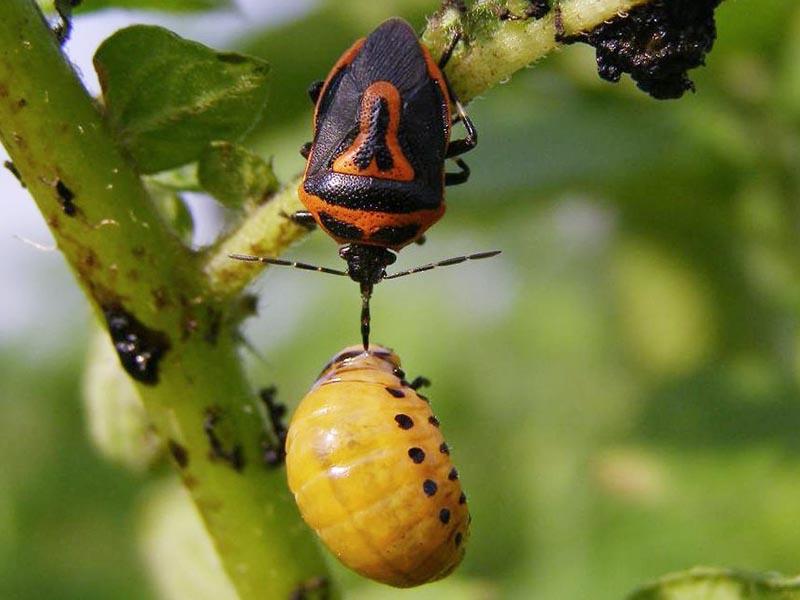
Picromerus
It belongs to the Shieldwings. It is distinguished from its brethren by its ability to diapause at the egg stage before the onset of winter. This predator attacks the Colorado potato beetle, and humans have learned to control the process of destroying the herbivorous insects.
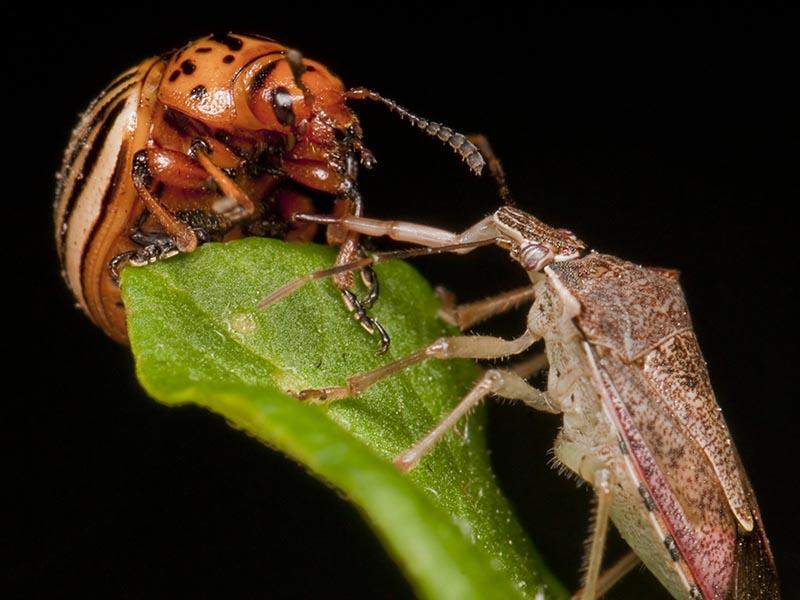
Predatory bed bugs are human enemies or friends
Predators are pests that feed on other species. And some of them attack fellow pests of a different species, but of the same family.
Such insects are not controlled because they help to destroy many dangerous pests, such as the Colorado potato beetle.
From this point of view, predators can be considered human friends. But they are not so safe.
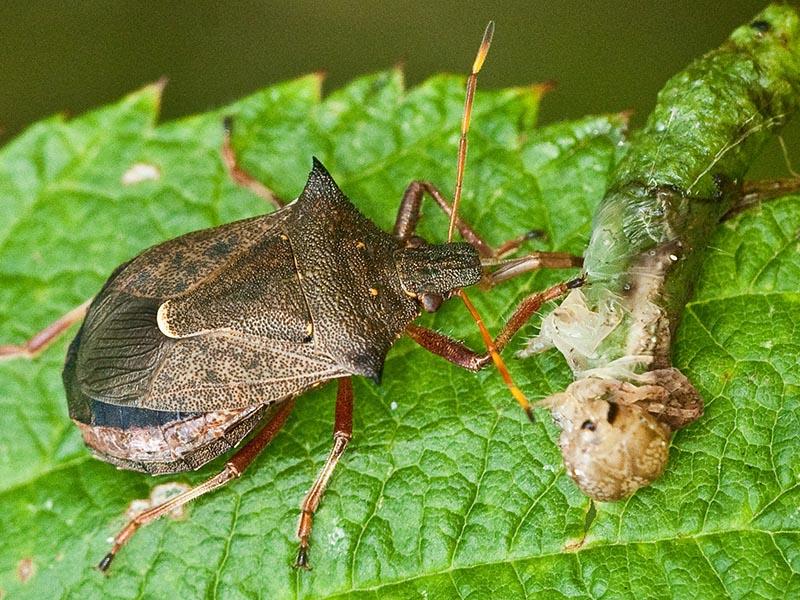
Do garden bugs bite?
When encountering a predator, it is important to remember that it will not attack purposefully. Such individuals do not feed on blood, in most cases they need plant sap. However, there are also dangerous bed bugs in the tropics.
Pests of these species bite, and quite painfully.
Only in contrast to tropical хищников, те насекомые, которые встречаются в нашей стране, не нападут на человека, пока он находится на безопасном расстоянии. Кусаются они с целью защиты, не более.

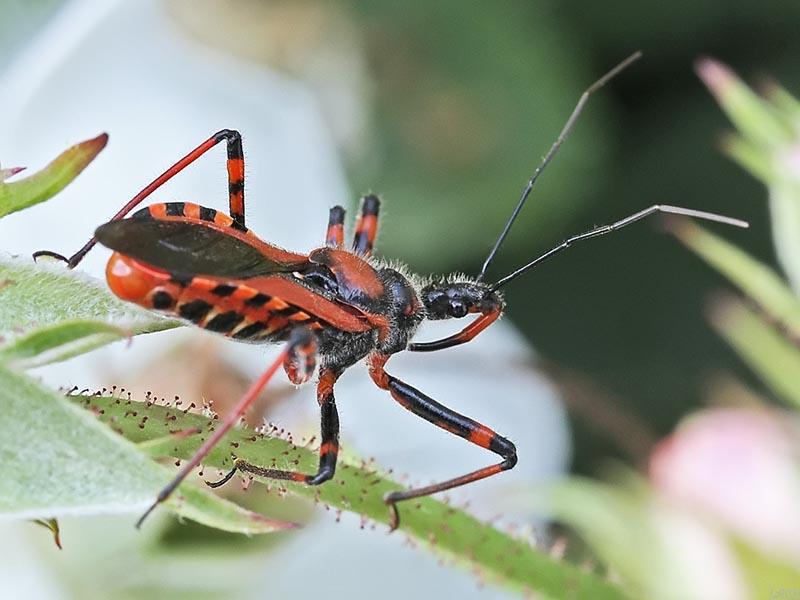
Famous Soldiers or Common Red Claws
These insects are familiar to everyone. The official names are: red bug, redbug. They are characterized by their black-red coloration, oval flat body. The pests have 3 pairs of limbs, 1 pair of antennae. They have 2 round, triangular-shaped black spots on the back and a red rim.
The diet is varied: fruits, plants, invertebrates (snails, worms), and other arthropods.
These insects are often found on the bark of trees. Soldiers usually sit on stumps and near fences. They overwinter in groups, which causes cannibalism when winters are warm and food sources are scarce.
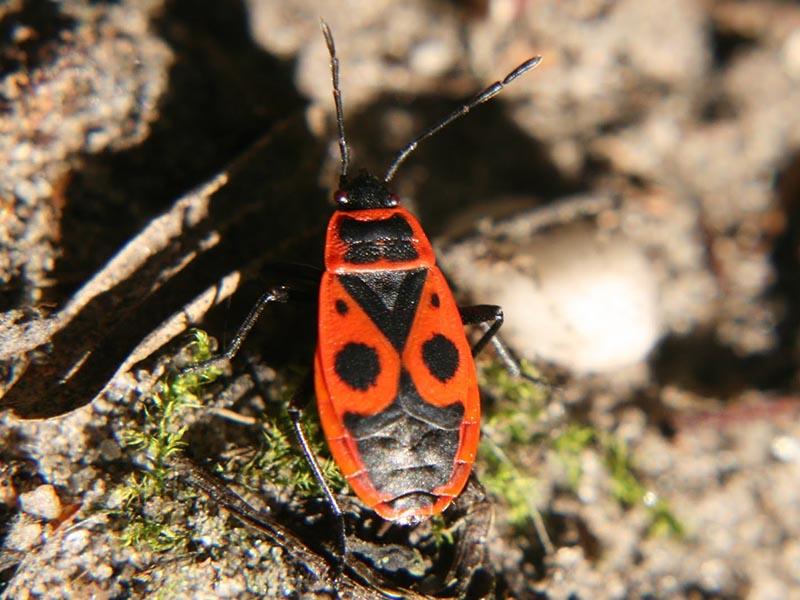
Garden bugs for alcoholism, an ancient grandmother's method. Recipes
This method cannot be the main one, it is used as an auxiliary measure to discourage an addicted person from drinking alcohol.
Using such a method of control does not guarantee getting rid of the need to drink alcohol, there are also risks of complications.

Tincture on garden bed bugs
If you still decide to get rid of the addiction in this way, you need to catch green wood or berry guillemots in the vegetable garden. They eat raspberries, so it is easier to catch such insects in bushes. Recipe:
- You will need 5-8 bedbugs, 500 ml of vodka.
- Insects are placed in a container filled with an alcoholic beverage.
- After 10 days the remedy for alcoholism will be ready. It must be strained before giving it to the person suffering from alcoholism.
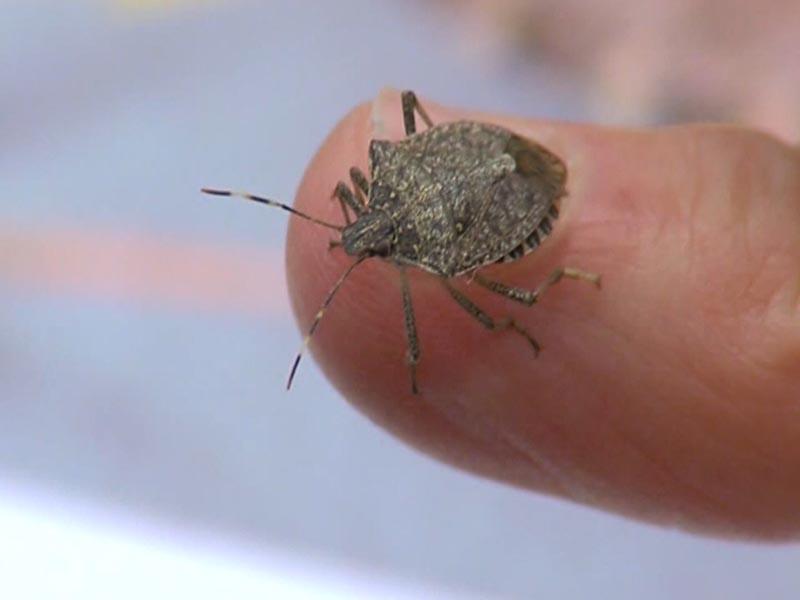
How to get rid of bed bugs in the garden
It is best to use a combined method. Several remedies against garden bugs are used simultaneously. The most effective ones include chemical drugs (Carbofos, Actellic, Aktara, etc.). But if there is no possibility to use them (for example, there is little time before the harvest) or the goal is to prevent infestation of the area in the next year, consider less aggressive ways.
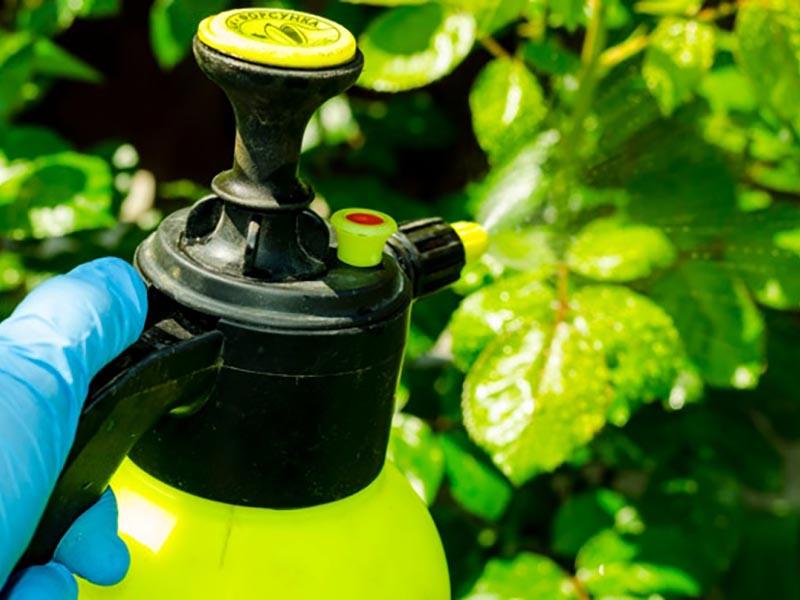
Biological methods
In this case, you need to count on the help of other insects, the natural enemies of plant-eating bed bugs. Today, it is possible to purchase some number of predators to disperse on a plot.
However, this method has a disadvantage - it is difficult to control the number of such insects.
Initially they are beneficial, but as the number of individuals increases, pests can pose a threat to other species (including beneficial ones).

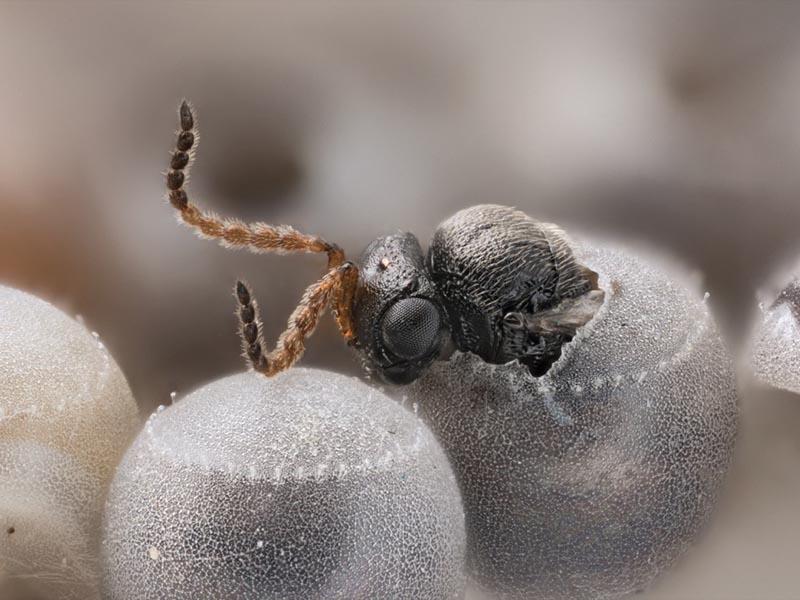
Agrotechnical tools
Activities that will help control pests (green forest guillemot, pest turtle, etc.):
- in the spring and fall (after harvesting) collect crop residues;
- Before the onset of winter and at the end of winter digging is carried out to a depth of at least 20 cm;
- planting of bedbug repellent plants, such as clopogon;
- weeding on a regular basis;
- early planting of crops;
- crop rotation.

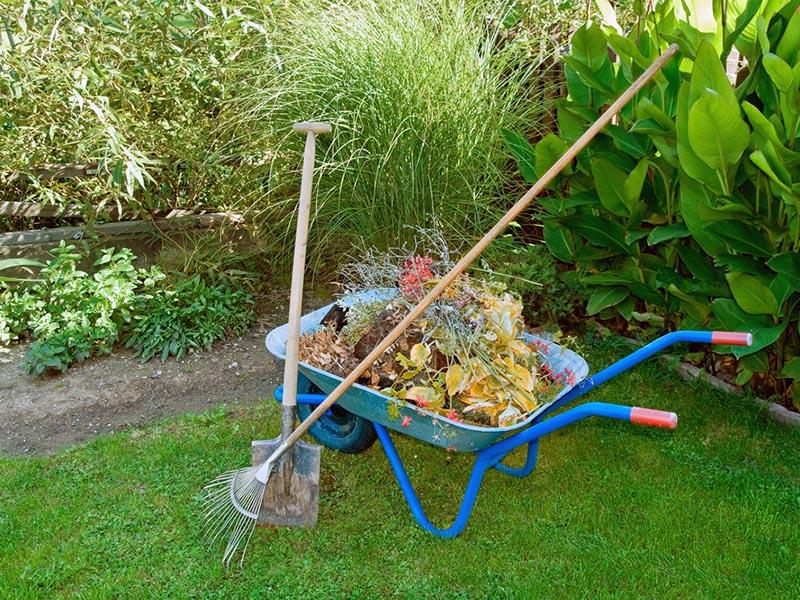
Folk recipes
If one chooses wayIf you have not found a way to combat garden bugs, you can also consider the use of improvised means. They are safe, effective at the stage when prevention of possible infestation is required (in early spring when pests settle after wintering). Recipes:
- Prepare: 10 liters of liquid, 250 grams of onion husks. The remedy is infused for 5 days. Some people prefer to boil it additionally. The duration of the infusion may be longer. Before application, the liquid is strained. Frequency of treatment of the area - every 4 days.
- Laundry soap. Take a shavings (300 g), 10 liters of water. It is enough to dissolve the soap, and then you can immediately apply the finished product. Frequency of treatment is 1 time every 7 days.
- Mustard powder is dissolved in water. You can treat plants with the liquid, but do it more often - every 3 days.
Vegetable gardeners' reviews
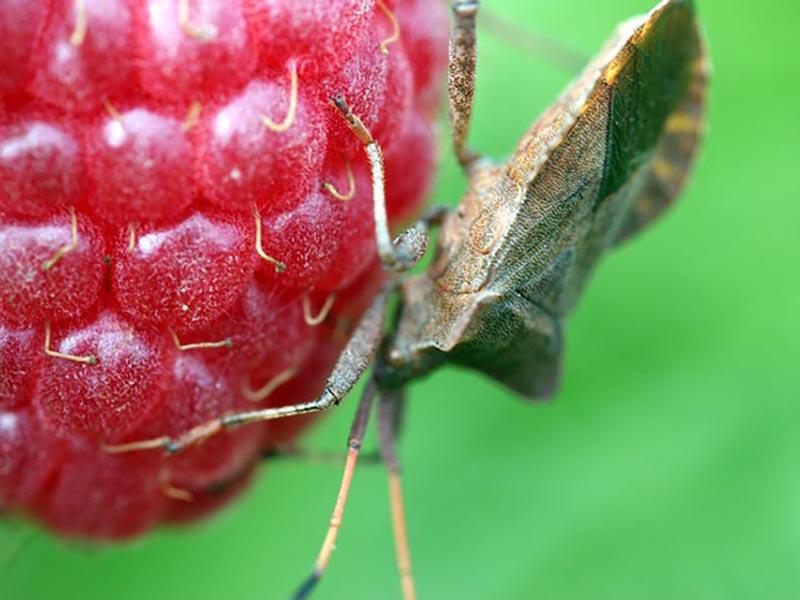
Expert tips

- method of extermination depends on the species of the parasite, for example, currant insects can remain unnoticed, against them do not work many means that are effective against the shields, so carefully inspect your plants, watch for changes in shape and size of all parts, including buds;
- If folk remedies are used, you must not forget to re-treat the area, when decoctions and infusions are sprayed irregularly, it nullifies the entire protective effect.
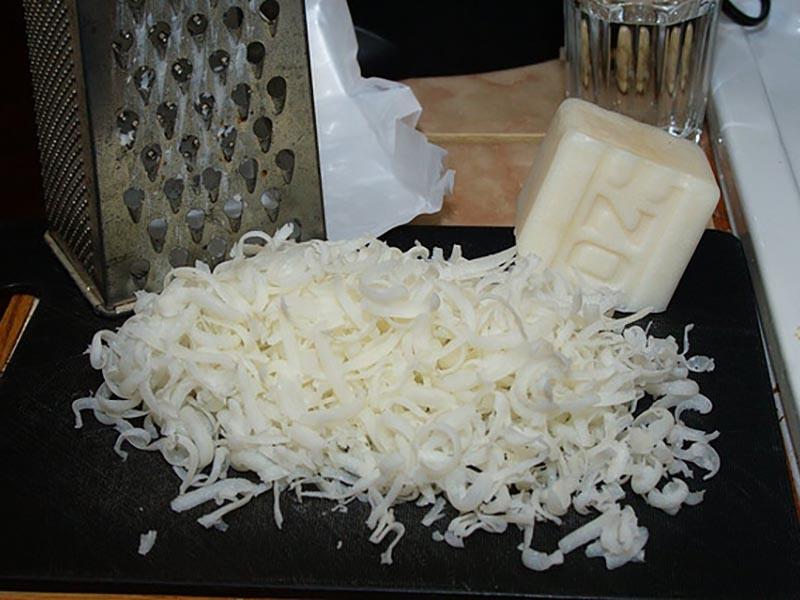
Conclusion
Garden bugs live in open spaces, they do not enter the apartment intentionally (accidental entry is possible). For this reason, it is necessary to fight them with methods designed for the treatment of vegetable gardens, gardens. Features of such pests:
- Appearance of garden pests is often similar: shield on back, bright coloring, body length 8-15 mm, 3 pairs of legs, tendrils. These individuals are able to fly, so it is not always possible to protect against them mechanically (by creating barriers, collecting by hand).
- Insects cause damage to plants: they pierce leaves, flowers, and suck sap. This introduces a substance that contributes to the disruption of the tissue structure of the plantation.
- Fighting The pests must be dealt with by a combined method. Consider the use of chemicals, and at the same time spray folk remedies (soap infusion, decoction of onion husks). The methods of prevention are also used, i.e., agricultural methods.
